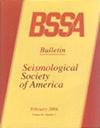利用条件生成对抗网络和广义反演技术生成特定地点的地动波形
IF 2.9
3区 地球科学
Q2 GEOCHEMISTRY & GEOPHYSICS
引用次数: 0
摘要
精确的地动模拟对于地震灾害评估和工程实践至关重要。在此,我们提出了一种结合条件生成对抗网络(cGANs)和广义反演技术(GIT)的新方法,用于生成特定场地和变异性控制的强震地震图。cGANs 可计算无振幅标度的合成地震图。广义反演技术(GIT)是从观测地震图的傅立叶振幅谱(FAS)中分离出震源、路径和场地特征。该方法应用于日本东北太平洋沿岸的板块边界地震。它成功生成了一组给定震级、距离和观测站的强震动地震图。输出波形再现了 P 波和 S 波以及尾波。我们使用峰值地面加速度 (PGA)、峰值地面速度、FAS、反应谱和波形持续时间等指标,在时域持续时间和频域振幅特征方面与观测到的地震图进行定量比较,从而验证了该方法。验证结果表明,观测地震图和合成地震图的峰值地面加速度的标准偏差为 0.643,地震图持续时间的标准偏差为 0.346,与之前研究的标准偏差相当。我们的方法为 1 秒或更短周期的随机微小震源建模提供了高精度。该方法的两个特点,即场地特异性和变异性控制,通过纳入基于观测地震图的经验信息,有助于进一步改进地震灾害评估。本文章由计算机程序翻译,如有差异,请以英文原文为准。
Site‐Specific Ground‐Motion Waveform Generation Using a Conditional Generative Adversarial Network and Generalized Inversion Technique
Accurate ground‐motion simulations are essential for seismic hazard assessments and engineering practices. Herein, we propose a novel method combining conditional generative adversarial networks (cGANs) and the generalized inversion technique (GIT) to generate site‐specific and variability‐controlled strong‐motion seismograms. The cGANs calculate synthetic seismogram without amplitude scales. The GIT is to separate the source, path, and site characteristics from the Fourier amplitude spectrum (FAS) of the observed seismograms. This method is applied to plate boundary earthquakes off the Pacific coast of Tohoku, Japan. It successfully generates a set of strong‐motion seismograms at a given magnitude, distance, and observation station. The output waveforms reproduce the P and S waves as well as coda waves. We validate the method through a quantitative comparison with observed seismograms in terms of both time‐domain duration and frequency‐domain amplitude characteristics, using metrics of peak ground acceleration (PGA), peak ground velocity, FASs, response spectra, and waveform duration time. The validation results show that the variation in the PGA of the observed seismograms and the synthetic seismograms has a standard deviation of 0.643, and the duration of the seismograms has a standard deviation of 0.346, comparable to the standard deviations seen in the previous studies. Our approach offers high accuracy in stochastic finite‐source modeling for a period of 1 s or shorter. The two features of the method, site‐specificity and variability control, can contribute to further improvements in seismic hazard assessment by incorporating empirical information based on observed seismograms.
求助全文
通过发布文献求助,成功后即可免费获取论文全文。
去求助
来源期刊

Bulletin of the Seismological Society of America
地学-地球化学与地球物理
CiteScore
5.80
自引率
13.30%
发文量
140
审稿时长
3 months
期刊介绍:
The Bulletin of the Seismological Society of America, commonly referred to as BSSA, (ISSN 0037-1106) is the premier journal of advanced research in earthquake seismology and related disciplines. It first appeared in 1911 and became a bimonthly in 1963. Each issue is composed of scientific papers on the various aspects of seismology, including investigation of specific earthquakes, theoretical and observational studies of seismic waves, inverse methods for determining the structure of the Earth or the dynamics of the earthquake source, seismometry, earthquake hazard and risk estimation, seismotectonics, and earthquake engineering. Special issues focus on important earthquakes or rapidly changing topics in seismology. BSSA is published by the Seismological Society of America.
 求助内容:
求助内容: 应助结果提醒方式:
应助结果提醒方式:


